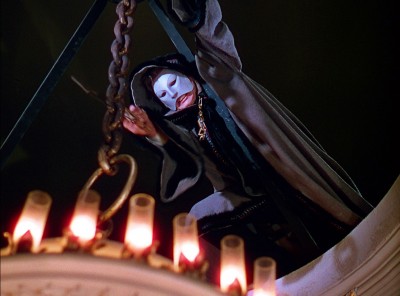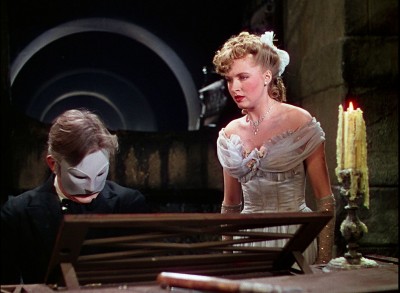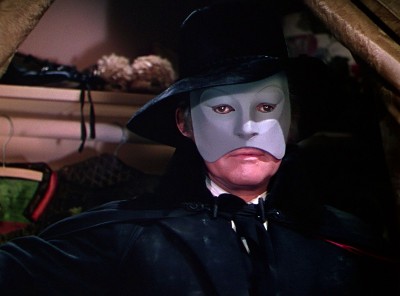
Maybe it’s because the 1943 Phantom of the Opera was the first version of the story I saw, but I’ve never shared in the disdain this movie has tended to get. Yes, I know the horror is downplayed and there is a lot of opera (or approximations of opera), but it has its own glorious Technicolor appeal—and did even when I was a kid watching it on a black-and-white TV. Despite the fact that Universal now embraces it as a horror film—well, it’s the one they still own—it was clearly conceived as something more along the lines of a melodramatic romance at the time. Look at the cast—not a Universal horror star to be found unless you count Claude Rains, and that’s a stretch. Instead Nelson Eddy gets top billing. By Universal standards, this was close to a prestige star (never mind that his last few films for MGM had been duds and his contract not renewed). And then there’s virtual newcomer Susanna Foster in whom Universal hoped they’d found another Deanna Durbin (they hadn’t). So, no, this was intended to be something “more” than a horror picture.

But horror was still an essential component to the story. Without it, there is no story. Well, the idea was to make the Phantom more sympathetic and less monstrous than Lon Chaney’s Erik from 1925. Apart from an obviously tacked-on bit about Chaney’s Phantom being an escapee from a lunatic asylum, Erik just “was.” Here—and oddly, this idea carried on to later films—Erique Claudin (Rains) is a violinist and composer with a yen for Christine (Foster), whom he’s secretly helping. (At one point in the scripting stages, he was supposed to turn out to be her father.) First, he gets canned from his violinist gig at the opera owing to arthritis in his fingers, then he gets acid thrown in his face when he goes mad and strangles a music publisher he thinks is stealing his nusic. This is how he becomes the Phantom. (Notice this is pretty closely followed in Brian De Palma’s 1974 film Phantom of the Paradise.) This is all well and good, except that a good chunk of the movie has elapsed before anything horrific has happened.

If the film never goes full-tilt horror until the somewhat rushed climax, it at least manages to retain a spooky tone, and boasts a few shocks and some exciting scenes. It’s rarely dull. (It’s really hard to believe that such a lackluster director as Arthur Lubin—known for Abbott and Costello movies, Francis the Talking Mule, etc.—made this film.)
Even the operas are excitingly done—with the last two incorporating melodramatic plot elements during the performances. Strangely, only the first opera really is an opera—Martha by Friedrich von Flotow, here translated into French. The other two are made up from music of Chopin and Tchaikovsky—complete with libretti written in English and translated into French. The reason for this seems to have been a fear of copyright issues, but it almost seems like it might just have been easier to fit the action to the music if you also controlled the music. (Edward Ward’s music and musical direction are both splendid.)

For a film that only sort-of qualifies as horror, there’s no denying that the big scene where the Phantom drops the chandelier on the audience is done much better here than it was in 1925. The final scenes where he takes Christine to his subterranean lair are good, too, even if this more realistic Phantom is more apt to raise practical questions like, “How did he lug that piano down to those catacombs?” (And this doesn’t ever take into consideration that these crumbling catacombs are right under the opera house and might pose a threat to its foundation.) But these are small concerns. The scene where Franz Liszt himself (Fritz Leiber) is playing Claudin’s concerto onstage at the opera, while Claudin plays it in the catacombs was a masterstroke, and one of the best things in any 1940s Universal horror. A mixed bag? Maybe so, but it’s still an enjoyable movie.
The Thursday Horror Picture Show will screen Phantom of the Opera Thursday, Feb. 27 at 8 p.m. in the Cinema Lounge at The Carolina Asheville and will be hosted by Xpress movie critics Ken Hanke and Justin Souther.




Mr. Hanke really hit the nail on the head in his review. So what if it doesn’t slavishly follow the previous Chaney film. It took its own approach, toned down the horror and made it more a romantic musical drama (with a little horror thrown in). And what a phantom–none other than the great Claude Rains! On stage we have the glorious voices of Nelson Eddy and lovely young newcomer Susanna Foster, together with Edgar Barrier thrown in for some light comedic bantering. It decided to go its own way and create rather than copy–and we’re all the luckier for it. Congratulations to all associated with this ravishingly beautiful production.